Garden of Wonders creates a feast for the nose and eyes in Milan’s Botanical Gardens

If the wisteria waterfalls of Brera's Botanical Garden (or the charming spread of gleaming, golden Laviani animal statues dotted around) don't get to you first, Be Open's Garden of Wonders will.
The international foundation of design and creativity has taken the world of fragrance to heady new heights with its latest project, a threefold approach to the world of fragrance. 'It is our way of proposing an alternative way - through design - to preserve traditions by adapting them to contemporary challenges and eventually explore new possibilities for small brands,' explains Be Open founder Yelena Baturina.
To begin with, the educational piece, 'A Journey Through Scent', narrates the evolution of perfume and fragrance - as well as its production and history - through an olfactory experience. Submerged in a dark mini-museum, large glass flasks and bottles hold what appear to be granules of salt. Giant atomisers reveals an ingenious way to share intense bursts of the different scents without these mixing up into a strange, sickly concoction.
Back in the garden, in the far side, the 'Houses of Wonder' are most exciting of all. These eight 'casitas' house pavilions have been created by various designers to revive and interpret long-forgotten perfume brands. Among the designers looking back at defunct luxury labels are Tord Boontje, Fernando and Humberto Campana, Dimore Studio, Front, Jaime Hayon, Piero Lissoni, Jean-Marie Massaud and Nendo. Their design aesthetic is clearly recognisable - the Campana Brothers interpretation of Veredas, for example, was inspired by Gruta do Veredas, a natural grotto in the state of Bahia in Brazil, and brought to life with a wicker, cave-like installation. Others, like Front and Dimore Studio, have taken a more sensory approach by using fading lights and the sound of rain respectively to illustrate their fragrances.
For the the third and final part of the project, 'A Vision in a Box', a golden cube-like display holds the bottles of nine totally different designers. Illustrating the importance of packaging, names such as Werner Aisslinger, GamFratesi, Mist-o and Thukral & Tagra have taken on the challenge of imagining bottles for the fragrance of the future.
The exhibition's Salone debut has undoubtedly been well received - no doubt in part thanks to the glorious weather which brings out the best of the Brera gardens - and is set to continue for EXPO 2015 in May.
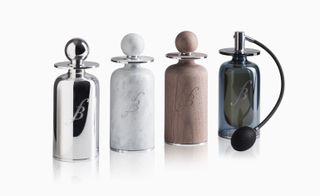
Jean-Marie Massaud created 'Bertif, a Timeless Scent', which was inspired by the alchemy of the very limited edition run of Bertiff, first launched in Paris in 1910

Toord Boontje's 'Scent and Psyche', an interpretation of Waldes et Spol, an early twentieth-century scent, which draws on themes of the belle époque in Paris and Vienna
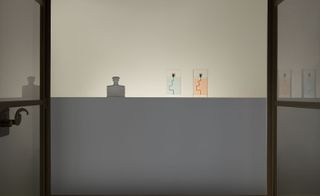
Nendo drew on Fandango by Koehler for this range of bottles. The two bottles, 'Fandango -12.3 ºC' and 'Fandango +23.1 ºC' are named for the average winter and summer temperatures in Moscow, the home of the Koehler perfumerie

Front's 'Fragrance Particles', which suspends the perfume in between two layers of glass
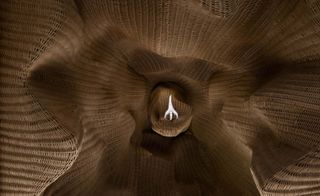
The Campana Brothers' wicker construction - an interpretation of Veredas - recalls a cave in Brazil
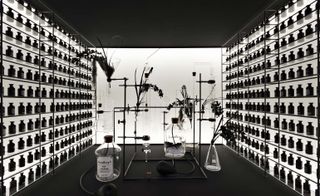
Jaime Hayon's 'Kuriopotek', a whimsical scent lab-cum-cabinet of curiosities
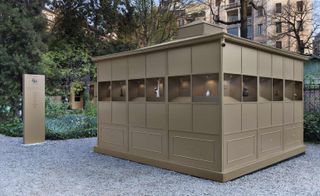
The third and final part of the project is 'A Vision in a Box', which houses nine bottle designs by as many designers, each of which has been inspired by a long-forgotten perfume brand
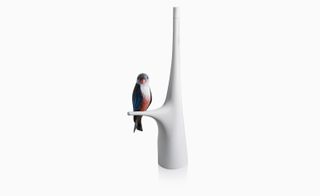
One of the bottles on show in this section is Misto-o's chirpy 'Voyage'

Thukral & Tagra's playful 'Submarine', also designed for 'A Vision in a Box'
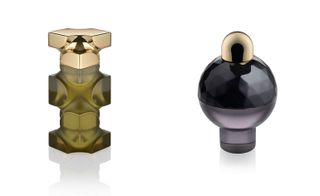
With nine different designers at work in 'A Vision in a Box', the variation is huge. Pictured here are two futurisic bottles by (left to right) Philippe Bestenheider and Karim Mekhtigian
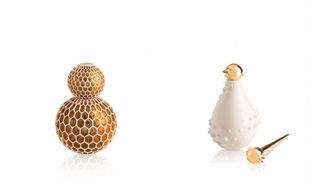
Werner Aisslinger's 'Coral' and Analogia Project's 'Spiny' bottles represent the more organic end of the spectrum on display

The architects Ludovica + Roberto Palomba have designed 'Ray Moore' (left), whose simplicity finds an echo in Victor Vasilev's Srebro, which translates as 'silver' in Slavic languages
ADDRESS
The Orto Botanico di Brera
via Brera 28
20121 Milano
Wallpaper* Newsletter
Receive our daily digest of inspiration, escapism and design stories from around the world direct to your inbox
-
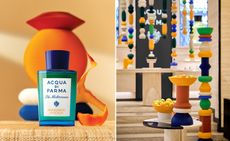 Discover Acqua di Parma’s new Mandarino di Sicilia fragrance at Milan Design Week 2024
Discover Acqua di Parma’s new Mandarino di Sicilia fragrance at Milan Design Week 2024Acqua di Parma and Fornice Objects bring the splendour of Sicilian mandarin fields to Milan to celebrate new fragrance Mandarino di Sicilia
By Simon Mills Published
-
 First look at Samba Room, London’s innovative cocktail lounge packed with Brazilian energy
First look at Samba Room, London’s innovative cocktail lounge packed with Brazilian energyLondon’s Samba Room, an extension of SushiSamba, is a dynamic bar, lounge and private dining space designed by Fabled Studio
By Tianna Williams Published
-
 Thom Browne shows how to make the perfect bed with theatrical performance at Milan Design Week 2024
Thom Browne shows how to make the perfect bed with theatrical performance at Milan Design Week 2024American fashion designer Thom Browne makes his Milan Design Week debut with a new homeware collection created in collaboration with historic linen company Frette
By Scarlett Conlon Published
-
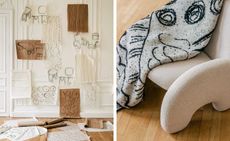 Faye Toogood brings new life to Matisse’s legacy
Faye Toogood brings new life to Matisse’s legacyMilan Design Week 2023: tapped by Maison Matisse, the London-based designer has taken inspiration from the French master’s forms to create a collection of heirloom-worthy objects
By Sam Rogers Published
-
 Prada Frames 2023: Milan programme announced
Prada Frames 2023: Milan programme announcedProgramme announced for Prada Frames 2023 at Milan Design Week, the annual symposium curated by Formafantasma at Luigi Caccia Dominioni's Teatro Filodrammatici from 17 to 19 April
By Rosa Bertoli Last updated
-
 Alessi Occasional Objects: Virgil Abloh’s take on cutlery
Alessi Occasional Objects: Virgil Abloh’s take on cutleryBest Cross Pollination: Alessi's cutlery by the late designer Virgil Abloh, in collaboration with his London studio Alaska Alaska, is awarded at the Wallpaper* Design Awards 2023
By Rosa Bertoli Published
-
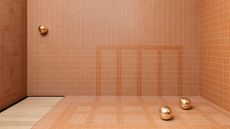 Salone del Mobile 2023: highlights from Milan Design Week
Salone del Mobile 2023: highlights from Milan Design WeekIn pictures: our highlights from Milan Design Week, held during the 61st Salone del Mobile 2023 (18-23 April)
By Rosa Bertoli Last updated
-
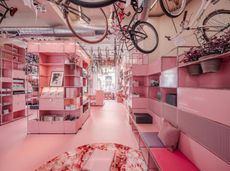 USM launches blushing pink limited edition of its modular furniture
USM launches blushing pink limited edition of its modular furnitureFollowing an installation during Milan Design Week 2022, USM launches a new pink limited edition of its Haller range
By Rosa Bertoli Last updated
-
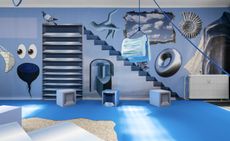 ‘You don't want space; you want to fill it’: Milan exhibition
‘You don't want space; you want to fill it’: Milan exhibitionMaking its debut during Milan Design Week 2022 at Marsèll Paradise, a new exhibition by Matylda Krzykowski, explores how we approach the space we live in (until 15 July 2022)
By Cristina Kiran Piotti Last updated
-
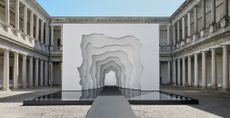 Kohler and Daniel Arsham brought experiential art to Milan Design Week
Kohler and Daniel Arsham brought experiential art to Milan Design WeekLooking back on Daniel Arsham and Kohler’s Divided Layers installation, and the brand’s latest bathroom collection
By Simon Mills Last updated
-
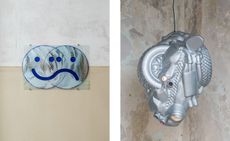 Men’s mental health takes centre stage at an art and design exhibition by Tableau
Men’s mental health takes centre stage at an art and design exhibition by Tableau‘Confessions’, which travels to Copenhagen’s 3 Days of Design following its debut at Milan Design Week 2022, features commissioned work by 14 male artists, designers and architects, reflecting on toxic masculinity, vulnerability and mental health
By TF Chan Last updated